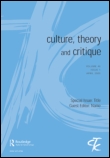 The aim of this special issue of Culture, Theory and Critique scheduled for April 2016 publication is to rethink the relationship between art history, on the one hand, and the development of a materialist philosophy of art on the other. There are three points that will provide the issue with its points of orientation.
The aim of this special issue of Culture, Theory and Critique scheduled for April 2016 publication is to rethink the relationship between art history, on the one hand, and the development of a materialist philosophy of art on the other. There are three points that will provide the issue with its points of orientation.
- The first stems from one of the most important recent developments within art history, namely the way historians of art, and their related projects, have become the focus of academic inquiry. This is to say that the writing of art history has itself been constituted as an object of study ; not only are there now detailed investigations of the art historical projects linked to Walter Benjamin and Aby Warburg, there is an increasing interest in and work on the writings of Wölflin, Wittkower, Wind, Saxl, Panofsky, to name some of the more important. The significance of this development is that it is beginning to provide a space in which the philosophical commitments of art history can be examined.
- In addition to this first development, there is a growing recognition that philosophical writing on art can no longer remain intentionally ignorant of art history or reduce the content of art history to a series of examples. The implication of this is that philosophical writing on art has to begin to take up the question of the history of art as already being a philosophical problem. In other words, philosophical writing on art is becoming increasingly aware of the fact that works of art are not just historical, but that the presentation of works of art within art history already involves specific determinations of historical time. In sum, art history brings with it, either implicitly or explicitly, commitments to different determinations of historical time.
- This idea of the specificity of the work of art plays out not only in time but also within the work of art itself. Indeed, the third point that we wish to address concerns the particular ways that works stage themselves as art, the ways in which the work of art is always a stage on which art’s works is played out. Art rarely, if ever, evinces the caricature of realism in which the work is taken to be no more than the immediate presence internally of that which is present externally, a position that can be defined as the Parrhasius myth. If this mythic structure were followed – and it is a structure that continues to haunt accounts of presentation – it would be as though internality were externality’s immediate presence. To the extent that this structure is not applicable – and its non-applicability can be taken as axiomatic – what works of art inscribe within themselves as part of their being as art is the way their presence is originally mediated. This is to say, then, that the process of mediation is part of the way the work stages itself as art. This process – art’s self-staging – is an important trope in the development of any philosophical encounter with the work of art. What is more, the latter, which is to say the presence of the work as originally mediated, means that any account of art’s work will demand recourse to art’s material presence. Or to put this another way, the impossibility of immediacy necessarily provides an opening towards a materialist philosophy of art.
We invite contributions that address any or all of these questions and that, therefore, interrogate the philosophical and theoretical contributions that might be born of a more situated form of philosophical writing on art in terms of historical and/or material specificity. Topics might include but are not restricted to :
- The work of art in Object Oriented Ontology;
- Speculative histories of art;
- The work of art criticism and/as philosophy;
- The work of art as criticism;
- The historicity of art history.
Completed essays in english should be submitted by February 1, 2015 at which time the editors will make initial decisions. All essays submitted will be subject to the normal double blind peer review processes used by Culture, Theory and Critique. Essays not chosen for the special issue may, if the author is in agreement, be considered for an open issue of the journal.
The length of essays is to be between 5,000-7,000 words including notes. Authors should follow the style guidelines found here: http://www.tandfonline.com/action/authorSubmission?journalCode=rctc20&page=instructions#.U7D-q_mSx8E
All submissions should be made online at the Culture, Theory and Critique ScholarOne Manuscripts site: http://mc.manuscriptcentral.com/rctc. New users should first create an account. Once logged on to the site, submissions should be made via the Author Centre. Online user guides and access to a helpdesk are available on this website. In the space provided, indicate that your essay should be considered for the special issue on “Art Matters” and please indicate also if you are happy for your essay to be considered for an open issue should it not be chosen for the special issue.
Send queries about the journal or availability to review for this special issue to Lisa Braverman, editorial assistant (ctcjourn@indiana.edu).
Editors :
Andrew Benjamin, Monash University (andrew.benjamin@monash.edu.au)
Greg Hainge, University of Queensland (g.hainge@uq.edu.au)

Leave a Reply
You must be logged in to post a comment.